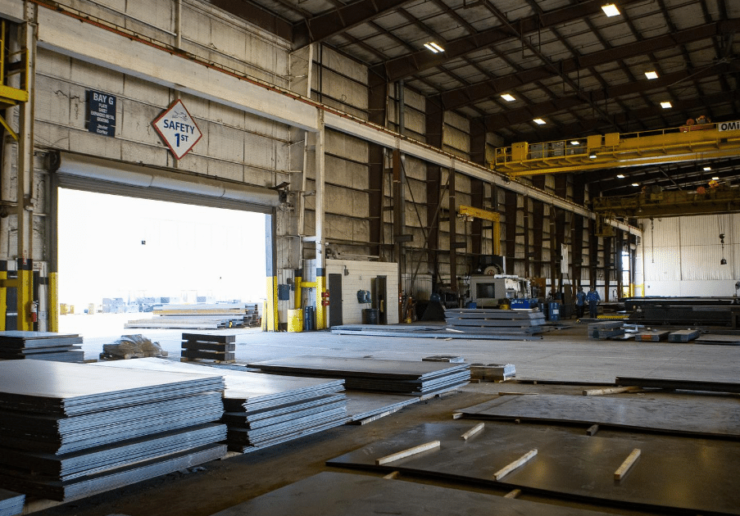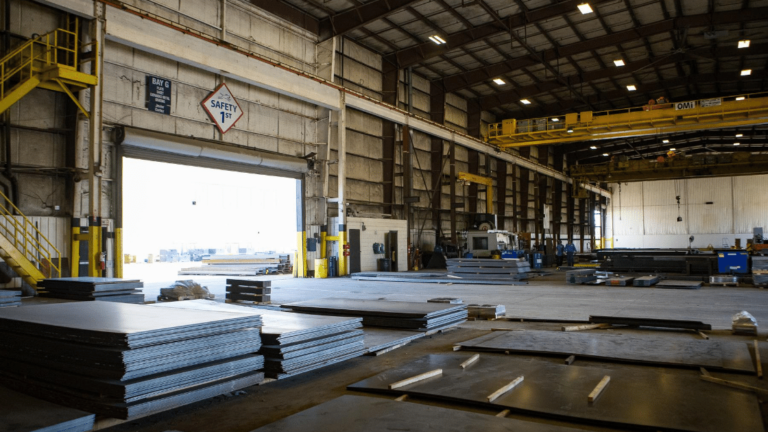Kloeckner Metals specializes in abrasion resistant steel plate and routinely supplies AR plate in a variety of grades and thicknesses alongside custom processing capabilities.

AR200 steel is an abrasion resistant medium steel plate. This AR plate is medium-carbon manganese steel with a moderate hardness of 212-255 Brinell Hardness. AR200 can be machined, punched, drilled, and formed and is known to be an inexpensive abrasion-resistant material. Typical applications are material chutes, material moving parts, truck liners.
Already a customer? Shop AR200 on Kloeckner Direct.
AR235 carbon steel plate has a nominal hardness of 235 Brinell Hardness. This AR plate is not meant for structural applications, but it is intended for moderate wear applications. Some typical applications are bulk material handling chute liners, skirt board liners, cement mixer drums and fins, and screw conveyors.
Already a customer? Shop AR235 on Kloeckner Direct.
AR Medium is an abrasion-resistant alloy steel plate that is a moderate wear material. This AR plate is available in both AR200 and AR235. Due to its abrasion resistance, it is often used in moderate wear applications. Some typical applications are material chutes, material moving equipment, truck liners, bulk material handling chute liners, skirt board liners, cement mixer drums and fins, and screw conveyors.
Already a customer? Shop AR Medium on Kloeckner Direct.
AR400 steel is designed for abrasion and wear-resistant applications. The high-carbon alloy steel grades are determined on the hardness of the steel. The AR400 steel plate is often used in applications where abrasion-resistant, formability, and weldability are required. Some typical industries are mining, material handling equipment, and aggregate.
Already a customer? Shop AR400 on Kloeckner Direct.
AR450 steel plate is an alloy composed of different elements, including carbon and boron. This AR plate offers more hardness than the AR400 steel plate while maintaining good formability, ductility, and impact resistance. Therefore, it is commonly used in moderate to heavy wear applications like bucket components, construction equipment, and dump body trucks.
Already a customer? Shop AR450 on Kloeckner Direct.
AR500 steel plate is a high-carbon steel alloy and has a surface hardness of 477-534 Brinell Hardness. This increase in strength and abrasion resistance provides a greater impact and sliding resistance but will make the steel less malleable. AR500 can resist wear and abrasion, both improving equipment’s longevity and increasing production time. Typical industries are mining, material handling, aggregate, dump trucks, material transfer chutes, storage bins, hoppers, and buckets.
AR600 steel plate is the most durable abrasion resistant plate that Kloeckner Metals offers. Due to its good abrasion resistance, it is ideal for excessive wear applications. The AR600 surface hardness is 570-640 Brinell Hardness and is often used in mining, aggregate removal, bucket, and high wear applications.
Already a customer? Shop AR600 on Kloeckner Direct.
AR200 steel is an abrasion resistant medium steel plate. This AR plate is medium-carbon manganese steel with a moderate hardness of 212-255 Brinell Hardness. AR200 can be machined, punched, drilled, and formed and is known to be an inexpensive abrasion-resistant material. Typical applications are material chutes, material moving parts, truck liners.
Already a customer? Shop AR200 on Kloeckner Direct.
AR235 carbon steel plate has a nominal hardness of 235 Brinell Hardness. This AR plate is not meant for structural applications, but it is intended for moderate wear applications. Some typical applications are bulk material handling chute liners, skirt board liners, cement mixer drums and fins, and screw conveyors.
Already a customer? Shop AR235 on Kloeckner Direct.
AR Medium is an abrasion-resistant alloy steel plate that is a moderate wear material. This AR plate is available in both AR200 and AR235. Due to its abrasion resistance, it is often used in moderate wear applications. Some typical applications are material chutes, material moving equipment, truck liners, bulk material handling chute liners, skirt board liners, cement mixer drums and fins, and screw conveyors.
Already a customer? Shop AR Medium on Kloeckner Direct.
AR400 steel is designed for abrasion and wear-resistant applications. The high-carbon alloy steel grades are determined on the hardness of the steel. The AR400 steel plate is often used in applications where abrasion-resistant, formability, and weldability are required. Some typical industries are mining, material handling equipment, and aggregate.
Already a customer? Shop AR400 on Kloeckner Direct.
AR450 steel plate is an alloy composed of different elements, including carbon and boron. This AR plate offers more hardness than the AR400 steel plate while maintaining good formability, ductility, and impact resistance. Therefore, it is commonly used in moderate to heavy wear applications like bucket components, construction equipment, and dump body trucks.
Already a customer? Shop AR450 on Kloeckner Direct.
AR500 steel plate is a high-carbon steel alloy and has a surface hardness of 477-534 Brinell Hardness. This increase in strength and abrasion resistance provides a greater impact and sliding resistance but will make the steel less malleable. AR500 can resist wear and abrasion, both improving equipment’s longevity and increasing production time. Typical industries are mining, material handling, aggregate, dump trucks, material transfer chutes, storage bins, hoppers, and buckets.
AR600 steel plate is the most durable abrasion resistant plate that Kloeckner Metals offers. Due to its good abrasion resistance, it is ideal for excessive wear applications. The AR600 surface hardness is 570-640 Brinell Hardness and is often used in mining, aggregate removal, bucket, and high wear applications.
Already a customer? Shop AR600 on Kloeckner Direct.

Unlike other steels that are formulated with tensile strength or other properties in mind, abrasion resistant steel plate is focused on Brinnell Hardness, one of the most important factors in abrasion resistance. Each grade is designated AR for its abrasion resistance and a numerical value for its Brinell Hardness. Abrasion Resistant steel plate shows up in applications wherever abrasion resistance is highly valued.
ANSWER:
While AR refers to “abrasion resistance,” the number in the grade, “400” or “500,” refers to the Brinell Hardness. AR500, therefore, has a higher Brinell Hardness than AR400.
Unlike other steels, where the primary properties taken into consideration are tensile strength or toughness, abrasion resistant steels are graded according to their Brinnell Hardness. Hardness is one of the most important factors when it comes to abrasion resistance.
Because of its impact and wear durability, AR400 is typically used when high wear resistance is a requirement, for example in digger blades and buckets, heavy machinery, and mining machinery. The addition of chromium increases its corrosion resistance, wear resistance, hardenability, and abrasion resistance.
AR500 is a medium carbon, abrasion resistant steel that is alloyed with manganese. Designed for impact resistance and wear, it has outstanding fatigue and corrosion resistance. AR500 is delivered heat treated for both hardening and better welding. Because of its durability, you’ll find AR500 frequently in truck trailers, concrete and aggregate industries, and mining equipment.
However, AR400 and AR500 aren’t so different that they aren’t interchangeable in many applications, like mining equipment, cement pouring and forming equipment, excavation equipment, and conveyor systems.
ANSWER:
When materials run against one another for an extended period of time, abrasion occurs. Sometimes, abrasion is intentional, as is the case with blasting, sanding, or grinding. But, when it’s unintentional, it can lead to structural or component failure. While steel in general stands out for its resistance to abrasion, not all steels are created equal, and some steels—abrasion resistant steels—are particularly suited for applications or environments where abrasion is expected.
ANSWER:
Like other steels, abrasion resistant steel is made from a combination of iron ore, carbon, and other alloys. First, undesirable substances are removed from the iron ore when it is melted in a blast furnace. At the same time, carbon and other alloys are added to the mix. Typically, abrasion resistant steels will be formulated with extra carbon and alloys like chromium and manganese for increased abrasion resistance. Afterwards, substances that prevent oxidation are added and the molten abrasion resistant steel is shaped, heat treated, and cut, now ready for final processing.
ANSWER:
While AR refers to “abrasion resistance,” the number in the grade, “400” or “500,” refers to the Brinell Hardness. AR500, therefore, has a higher Brinell Hardness than AR400.
Unlike other steels, where the primary properties taken into consideration are tensile strength or toughness, abrasion resistant steels are graded according to their Brinnell Hardness. Hardness is one of the most important factors when it comes to abrasion resistance.
Because of its impact and wear durability, AR400 is typically used when high wear resistance is a requirement, for example in digger blades and buckets, heavy machinery, and mining machinery. The addition of chromium increases its corrosion resistance, wear resistance, hardenability, and abrasion resistance.
AR500 is a medium carbon, abrasion resistant steel that is alloyed with manganese. Designed for impact resistance and wear, it has outstanding fatigue and corrosion resistance. AR500 is delivered heat treated for both hardening and better welding. Because of its durability, you’ll find AR500 frequently in truck trailers, concrete and aggregate industries, and mining equipment.
However, AR400 and AR500 aren’t so different that they aren’t interchangeable in many applications, like mining equipment, cement pouring and forming equipment, excavation equipment, and conveyor systems.
ANSWER:
When materials run against one another for an extended period of time, abrasion occurs. Sometimes, abrasion is intentional, as is the case with blasting, sanding, or grinding. But, when it’s unintentional, it can lead to structural or component failure. While steel in general stands out for its resistance to abrasion, not all steels are created equal, and some steels—abrasion resistant steels—are particularly suited for applications or environments where abrasion is expected.
ANSWER:
Like other steels, abrasion resistant steel is made from a combination of iron ore, carbon, and other alloys. First, undesirable substances are removed from the iron ore when it is melted in a blast furnace. At the same time, carbon and other alloys are added to the mix. Typically, abrasion resistant steels will be formulated with extra carbon and alloys like chromium and manganese for increased abrasion resistance. Afterwards, substances that prevent oxidation are added and the molten abrasion resistant steel is shaped, heat treated, and cut, now ready for final processing.
Between our global footprint, international transportation network,...

X
The Kloeckner Metals website uses modern technologies. Unfortunately, your browser doesn't support those technologies.
Download the latest version of one of these browsers to experience the site: